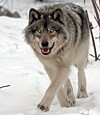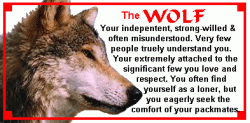


The wolf also passed along to dogs its most indispensable qualities: devotion to its pack, sociability, and a capacity for learning, communication, and expression.Lone-wolf terrorist attacks have occurred in the United States throughout the countrys history. We transformed the wolf’s skill at harassing and maneuvering big grazing animals into a herding instinct, helping us move our livestock from place to place. We put the wolf’s superior sense of smell and knack for locating prey to use as trackers and retrievers on our own hunts. We capitalized on the wolf’s territorialism to create a dog that steadfastly guarded our flocks and property. The traits that wolves passed on to dogs served us well as we became shepherds and farmers. Just like elephants, gorillas and whales, they educate their young, take care of their injured and live in family groups. You can see a lot of your dog in a wolf and a lot of wolf in your dog. The DNA of any dog is almost exactly the same as that of a wolf. Genetics leaves little doubt that domestic dogs, our canine companions, are descended from wolves. When we look at wolves, we are looking at tribes-extended families, each with its own homeland, history, knowledge, and indeed, culture. When they lose a pack mate, there is evidence that they suffer and mourn that loss. Wolves play together into old age, they raise their young as a group, and they care for injured companions. A family group can persevere for several generations, even decades, carrying knowledge and information through the years, from generation to generation. Wolves and other highly social animals have and pass on what can be best described as culture. Pack structure enables communication, the education of the young and the transfer of knowledge across generations. They form friendships and nurture their own sick and injured. Wolves care for each other as individuals. Living in a pack not only facilitates the raising and feeding of pups, coordinated and collaborative hunting, and the defense of territory, it also allows for the formation of many unique emotional bonds between pack members, the foundation for cooperative living. Although an omega may hold that position for many years, it is not unheard of for the pack to pick a new omega and let the other retire. Both mid- and low-ranking positions are somewhat fluid.

In small packs, human-caused mortality of the alpha female and/or the alpha male can cause the entire pack to dissolve.Īfter the alphas, wolves second in command are called the betas, followed by mid-ranking wolves, and finally the omegas.

The loss of a parent can have a devastating impact on social group cohesion. They, especially the alpha female (the mother of the pack), are the glue keeping the pack together. Typically, there is only one breeding pair in a pack. The job of maintaining order and cohesion falls largely to the alphas, also known as the breeding pair. There are old wolves that need to be cared for, pups that need to be educated, and young adults that are beginning to assert themselves – all altering the dynamics of the pack. A wolf pack is an exceedingly complex social unit-an extended family of parents, offspring, siblings, aunts, uncles, and sometimes dispersers from other packs.


 0 kommentar(er)
0 kommentar(er)
